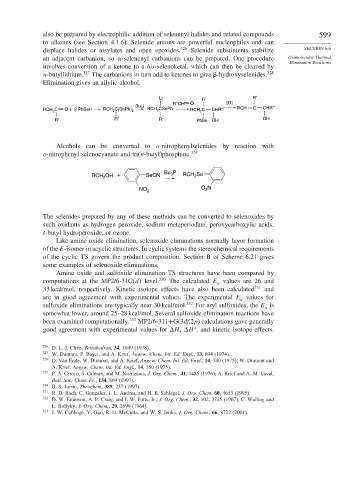Page 625 - Advanced Organic Chemistry Part B - Reactions & Synthesis
P. 625
also be prepared by electrophilic addition of selenenyl halides and related compounds 599
to alkenes (see Section 4.1.6). Selenide anions are powerful nucleophiles and can
displace halides or tosylates and open epoxides. 326 Selenide substituents stabilize SECTION 6.6
an adjacent carbanion, so -selenenyl carbanions can be prepared. One procedure Unimolecular Thermal
Elimination Reactions
involves conversion of a ketone to a bis-selenoketal, which can then be cleaved by
n-butyllithium. 327 The carbanions in turn add to ketones to give -hydroxyselenides. 328
Elimination gives an allylic alcohol.
Li R′ R′
R′′CH O [O]
BuLi
C O + 2 PhSeH RCH C(SePh) CSePh CHR′′ RCH C CHR′′
RCH 2 2 2 RCH 2 RCH C
2
R′ R′ R′ PhSe OH OH
Alcohols can be converted to o-nitrophenylselenides by reaction with
o-nitrophenyl selenocyanate and tri(n-butyl)phosphine. 329
P
OH + SeCN RCH Se
Bu 3
RCH 2 2
NO 2 O N
2
The selenides prepared by any of these methods can be converted to selenoxides by
such oxidants as hydrogen peroxide, sodium metaperiodate, peroxycarboxylic acids,
t-butyl hydroperoxide, or ozone.
Like amine oxide elimination, selenoxide eliminations normally favor formation
of the E-isomer in acyclic structures. In cyclic systems the stereochemical requirements
of the cyclic TS govern the product composition. Section B of Scheme 6.21 gives
some examples of selenoxide eliminations.
Amine oxide and sulfoxide elimination TS structures have been compared by
computations at the MP2/6-31G(d) level. 330 The calculated E values are 26 and
a
33 kcal/mol, respectively. Kinetic isotope effects have also been calculated 331 and
are in good agreement with experimental values. The experimental E values for
a
sulfoxide eliminations are typically near 30 kcal/mol. 332 For aryl sulfoxides, the E is
a
somewhat lower, around 25–28 kcal/mol. Several sulfoxide elimination reactions have
been examined computationally. 333 MP2/6-311+G(3df,2p) calculations gave generally
good agreement with experimental values for
H,
H , and kinetic isotope effects.
‡
326
D. L. J. Clive, Tetrahedron, 34, 1049 (1978).
327 W. Dumont, P. Bayet, and A. Krief, Angew. Chem. Int. Ed. Engl., 13, 804 (1974).
328
D. Van Ende, W. Dumont, and A. Krief, Angew. Chem. Int. Ed. Engl., 14, 700 (1975); W. Dumont and
A. Krief, Angew. Chem. Int. Ed. Engl., 14, 350 (1975).
329 P. A. Grieco, S. Gilman, and M. Nishizawa, J. Org. Chem., 41, 1485 (1976); A. Krief and A.-M. Laval,
Bull. Soc. Chim. Fr., 134, 869 (1997).
330 B. S. Jursic, Theochem, 389, 257 (1997).
331
R. D. Bach, C. Gonzalez, J. L. Andres, and H. B. Schlegel, J. Org. Chem, 60, 4653 (1995).
332 D. W. Emerson, A. P. Craig, and I. W. Potts, Jr., J. Org. Chem., 32, 102, 3725 (1967); C. Walling and
L. Bollyky, J. Org. Chem., 29, 2699 (1964).
333
J. W. Cubbage, Y. Guo, R. D. McCulla, and W. S. Jenks, J. Org. Chem., 66, 8722 (2001).

